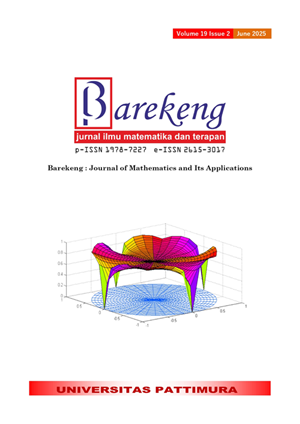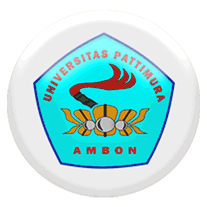TIME SERIES MODEL FOR TRAIN PASSENGER FORECASTING
Abstract
Trains as a means of public transportation have an important role in connecting various regions of Jabodetabek. Therefore, it is necessary to have a deep understanding of the trend of train passenger movements and predict the number of train passengers in the next period in order to optimize the management and service of train passengers properly. In this study, we examine two methods that can be used as forecasting methods for train passenger data sourced from the Central Statistics Agency (BPS), namely ARIMA and Prophet. This study demonstrates that the optimal ARIMA model is ARIMA (0,2,1), achieving a Mean Absolute Percentage Error (MAPE) of 4.91% and a Root Mean Square Error (RMSE) of 1754.970. In addition, the Prophet model, which is an additive regression model designed by Facebook for time series forecasting was also obtained with a MAPE of 0.04% and an RMSE of 1170.59. Considering the MAPE and RMSE values of the two models, the Prophet model emerges as the most suitable for forecasting the number of train passengers in the Jabodetabek region.
Downloads
References
E. Choiriyah, U. D. Syafitri, and I. M. Sumertajaya, “PENGEMBANGAN MODEL PERAMALAN SPACE TIME,” Indonesian Journal of Statistics and Its Applications, vol. 4, no. 4, pp. 579–589, Dec. 2020, doi: 10.29244/ijsa.v4i4.584.
A. A. Ariyo, A. O. Adewumi, and C. K. Ayo, “STOCK PRICE PREDICTION USING THE ARIMA MODEL,” in 2014 UKSim-AMSS 16th International Conference on Computer Modelling and Simulation, IEEE, Mar. 2014, pp. 106–112. doi: 10.1109/UKSim.2014.67.
A. L. Schaffer, T. A. Dobbins, and S.-A. Pearson, “INTERRUPTED TIME SERIES ANALYSIS USING AUTOREGRESSIVE INTEGRATED MOVING AVERAGE (ARIMA) MODELS: A GUIDE FOR EVALUATING LARGE-SCALE HEALTH INTERVENTIONS,” BMC Med Res Methodol, vol. 21, no. 1, p. 58, Dec. 2021, doi: 10.1186/s12874-021-01235-8.
S. J. Taylor and B. Letham, “FORECASTING AT SCALE,” Am Stat, vol. 72, no. 1, pp. 37–45, Jan. 2018, doi: 10.1080/00031305.2017.1380080.
T. Toharudin, R. S. Pontoh, R. E. Caraka, S. Zahroh, Y. Lee, and R. C. Chen, “EMPLOYING LONG SHORT-TERM MEMORY AND FACEBOOK PROPHET MODEL IN AIR TEMPERATURE FORECASTING,” Commun Stat Simul Comput, vol. 52, no. 2, pp. 279–290, Feb. 2023, doi: 10.1080/03610918.2020.1854302.
J. Chang and X. Song, “A RAILWAY PASSENGER FLOW PREDICTION MODEL BASED ON IMPROVED PROPHET,” IN 2023 4TH INTERNATIONAL CONFERENCE ON MACHINE LEARNING AND COMPUTER APPLICATION, New York, NY, USA: ACM, Oct. 2023, pp. 798–804. doi: 10.1145/3650215.3650354.
D. D. Chuwang and W. Chen, “FORECASTING DAILY AND WEEKLY PASSENGER DEMAND FOR URBAN RAIL TRANSIT STATIONS BASED ON A TIME SERIES MODEL APPROACH,” Forecasting, vol. 4, no. 4, pp. 904–924, Nov. 2022, doi: 10.3390/forecast4040049.
N. Q. D. H. B. Sitepu, N. S. Sutarman, and N. M. A. P. Siregar, “METODE AUTOREGRESSIVE INTEGRATED MOVING AVERAGE (ARIMA) DALAM MEMPREDIKSI JUMLAH PENUMPANG KERETA API KOTA BINJAI,” Jurnal Arjuna Publikasi Ilmu Pendidikan Bahasa Dan Matematika, vol. 2, no. 2, pp. 69–85, Jan. 2024, doi: 10.61132/arjuna.v2i2.621.
M. Nar and S. Arslankaya, “PASSENGER DEMAND FORECASTING FOR RAILWAY SYSTEMS,” Open Chemistry, vol. 20, no. 1, pp. 105–119, Jan. 2022, doi: 10.1515/chem-2022-0124.
BPS Indonesia, “JUMLAH PENUMPANG KERETA API - TABEL STATISTIK,” Badan Pusat Statistik, 2023. https://www.bps.go.id/id/statistics-table/2/NzIjMg==/jumlah-penumpang-kereta-api.html
Y. Liu, H. Wu, J. Wang, and M. Long, “NON-STATIONARY TRANSFORMERS: EXPLORING THE STATIONARITY IN TIME SERIES FORECASTING.” [Online]. Available: https://github.com/thuml/Nonstationary_Transformers.
S. Guan et al., “THE PROFILES OF NON-STATIONARITY AND NON-LINEARITY IN THE TIME SERIES OF RESTING-STATE BRAIN NETWORKS,” Front Neurosci, vol. 14, Jun. 2020, doi: 10.3389/fnins.2020.00493.
N. W. Ngestisari, “THE PERBANDINGAN METODE ARIMA DAN JARINGAN SYARAF TIRUAN UNTUK PERAMALAN HARGA BERAS,” Indonesian Journal of Data and Science, vol. 1, no. 3, Dec. 2020, doi: 10.33096/ijodas.v1i3.18.
V. P. Ariyanti and N. T. Yusnitasari, “COMPARISON OF ARIMA AND SARIMA FOR FORECASTING CRUDE OIL PRICES,” Jurnal RESTI (Rekayasa Sistem Dan Teknologi Informasi), vol. 7, no. 2, pp. 405–413, Mar. 2023, doi: 10.29207/resti.v7i2.4895.
P.J. Brockwell and R.A. Davis, INTRODUCTION TO TIME SERIES AND FORECASTING. New York: Springer, 2016.
A. N. A. Mahmad Azan, N. F. A. Mohd Zulkifly Mototo, and P. J. W. Mah, “THE COMPARISON BETWEEN ARIMA AND ARFIMA MODEL TO FORECAST KIJANG EMAS (GOLD) PRICES IN MALAYSIA USING MAE, RMSE AND MAPE,” Journal of Computing Research and Innovation, vol. 6, no. 3, pp. 22–33, Sep. 2021, doi: 10.24191/jcrinn.v6i3.225.
S. Bouhaddour, C. Saadi, I. Bouabdallaoui, F. Guerouate, and M. Sbihi, “TOURISM IN SINGAPORE, PREDICTION MODEL USING SARIMA AND PROPHET,” 2023, p. 020042. doi: 10.1063/5.0131288.
V. Nur Aziza, F. H. Moh’d, F. A. Maghfiroh, K. A. Notodiputro, and Y. Angraini, “PERFORMANCE COMPARISON OF SARIMA INTERVENTION AND PROPHET MODELS FOR FORECASTING THE NUMBER OF AIRLINE PASSENGER AT SOEKARNO-HATTA INTERNATIONAL AIRPORT,” BAREKENG: Jurnal Ilmu Matematika dan Terapan, vol. 17, no. 4, 2023, doi: 10.30598/barekengvol17iss4pp2107-2120.
G. Borowik, Z. M. Wawrzyniak, and P. Cichosz, “TIME SERIES ANALYSIS FOR CRIME FORECASTING,” Proc. IEEE 26th International Conference on System Engineering (ICSEng), pp. 1–10, Dec. 2018, doi: 10.1109/icseng.2018.8638179.
Copyright (c) 2025 Bashir Ammar Hakim, Billy Billy, Khairil Anwar Notodiputro, Yenni Angraini, Laily Nissa Atul Mualifah

This work is licensed under a Creative Commons Attribution-ShareAlike 4.0 International License.
Authors who publish with this Journal agree to the following terms:
- Author retain copyright and grant the journal right of first publication with the work simultaneously licensed under a creative commons attribution license that allow others to share the work within an acknowledgement of the work’s authorship and initial publication of this journal.
- Authors are able to enter into separate, additional contractual arrangement for the non-exclusive distribution of the journal’s published version of the work (e.g. acknowledgement of its initial publication in this journal).
- Authors are permitted and encouraged to post their work online (e.g. in institutional repositories or on their websites) prior to and during the submission process, as it can lead to productive exchanges, as well as earlier and greater citation of published works.






1.gif)



